Electrostatic Deposition of Large-Surface Graphene
Abstract
1. Introduction
2. Results and Discussion
3. Materials and Methods
3.1. Electrostatic Deposition Setup
3.2. Pre-Patterning and Cleaving of the HOPG Block
3.3. Deposition and Characterization
4. Conclusions
Acknowledgments
Author Contributions
Conflicts of Interest
References
- Geim, A.K. Graphene prehistory. Phys. Scr. 2012, 2012, 014003. [Google Scholar] [CrossRef]
- Geim, A.K.; Novoselov, K.S. The rise of graphene. Nat. Mater. 2007, 6, 183–191. [Google Scholar] [CrossRef] [PubMed]
- Hancock, Y. The 2010 Nobel Prize in physics—Ground-breaking experiments on graphene. J. Phys. D Appl. Phys. 2011, 44, 473001. [Google Scholar] [CrossRef]
- Lu, X.; Yu, M.; Huang, G.; Ruoff, R.S. Tailoring graphite with the goal of achieving single sheets. Nanotechnology 1999, 10, 269–272. [Google Scholar] [CrossRef]
- Bunch, J.S. Mechanical and electrical properties of graphene sheets. In Department of Philosophy; Cornell University: Ithaca, NY, USA, 2008; p. 140. [Google Scholar]
- Chernozatonskii, L.A.; Sorokin, P.B.; Artukh, A.A. Novel graphene-based nanostructures: Physicochemical properties and applications. Russ. Chem. Rev. 2014, 83, 251–279. [Google Scholar] [CrossRef]
- Mohiuddin, T.M.G.; Lombardo, A.; Nair, R.R.; Bonetti, A.; Savini, G.; Jalil, R.; Bonini, N.; Basko, D.M.; Galiotis, C.; Marzari, N.; et al. Uniaxial strain in graphene by Raman spectroscopy: G peak splitting, Gruneisen parameters, and sample orientation. Phys. Rev. B 2009, 79, 205433. [Google Scholar] [CrossRef]
- Van der Zande, A.M.; Barton, R.A.; Alden, J.S.; Ruiz-Vargas, C.S.; Whitney, W.S.; Pham, P.H.; Park, J.; Parpia, J.M.; Craighead, H.G.; McEuen, P.L. Large-Scale Arrays of Single-Layer Graphene Resonators. Nano Lett. 2010, 10, 4869–4873. [Google Scholar] [CrossRef] [PubMed]
- Chen, C.-H.; Reddy, K.M.; Padture, N.P. Site-specific stamping of graphene micro-patterns over large areas using flexible stamps. Nanotechnology 2012, 23, 235603. [Google Scholar] [CrossRef] [PubMed]
- Hidefumi, H.; Hisao, M.; Kazuhito, T. Determination of the Number of Graphene Layers: Discrete Distribution of the Secondary Electron. Intensity Stemming from Individual Graphene Layers. Appl. Phys. Express 2010, 3, 095101. [Google Scholar]
- Jayasena, B.; Reddy, C.D.; Subbiah, S. Separation, folding and shearing of graphene layers during wedge-based mechanical exfoliation. Nanotechnology 2013, 24, 205301. [Google Scholar] [CrossRef] [PubMed]
- Yu, Q.; Jauregui, L.A.; Wu, W.; Colby, R.; Tian, J.; Su, Z.; Cao, H.; Liu, Z.; Pandey, D.; Wei, D.; et al. Control and characterization of individual grains and grain boundaries in graphene grown by chemical vapour deposition. Nat. Mater. 2011, 10, 443–449. [Google Scholar] [CrossRef]
- Bonaccorso, F.; Sun, Z.; Hasan, T.; Ferrari, A.C. Graphene photonics and optoelectronics. Nat. Photonics 2010, 4, 611–622. [Google Scholar] [CrossRef]
- Dai, X.; Jiang, L.; Xiang, Y. Tunable optical bistability of dielectric/nonlinear graphene/dielectric heterostructures. Opt. Express 2015, 23, 6497–6508. [Google Scholar] [CrossRef] [PubMed]
- Hwang, G.; Acosta, J.C.; Vela, E.; Haliyo, S.; Régnier, S. Graphene as thin film infrared optoelectronic sensor. In Proceedings of the International Symposium on Optomechatronic Technologies (ISOT 2009), Istanbul, Turkey, 21–23 September 2009. [Google Scholar]
- Gunasekaran, V.; Kim, S.J. Observation of diode-like characteristics in planar-type structures of graphite flakes. J. Phys. Conf. Ser. 2009, 150, 022039. [Google Scholar] [CrossRef]
- Zhang, Y.; Liu, T.; Meng, B.; Li, X.; Liang, G.; Hu, X.; Wang, Q.J. Broadband high photoresponse from pure monolayer graphene photodetector. Nat. Commun. 2013, 4, 1811. [Google Scholar] [CrossRef] [PubMed]
- Allen, M.T.; Martin, J.; Yacoby, A. Gate-defined quantum confinement in suspended bilayer graphene. Nat. Commun. 2012, 3, 934. [Google Scholar] [CrossRef] [PubMed]
- Beidaghi, M.; Wang, Z.; Gu, L.; Wang, C. Electrostatic spray deposition of graphene nanoplatelets for high-power thin-film supercapacitor electrodes. J. Solid State Electrochem. 2012, 16, 3341–3348. [Google Scholar] [CrossRef]
- Reddy, D.; Register, L.F.; Carpenter, G.D.; Banerjee, S.K. Graphene field-effect transistors. J. Phys. D Appl. Phys. 2011, 44, 313001. [Google Scholar] [CrossRef]
- Fal’ko, V.I. Electronic properties and the quantum Hall effect in bilayer graphene. Phys. Eng. Sci. 2008, 366, 205–219. [Google Scholar] [CrossRef] [PubMed]
- Ferrari, A.C. Raman spectroscopy of graphene and graphite: Disorder, electron–phonon coupling, doping and nonadiabatic effects. Solid State Commun. 2007, 143, 47–57. [Google Scholar] [CrossRef]
- Kliros, G.S. Quantum capacitance of bilayer graphene. In Proceedings of the International 2010 on Semiconductor Conference (CAS), Sinaia, Romania, 11–13 October 2010. [Google Scholar]
- Ni, Z.; Liu, L.; Wang, Y.; Zheng, Z.; Li, L.J.; Yu, T.; Shen, Z. G-band Raman double resonance in twisted bilayer graphene: Evidence of band splitting and folding. Phys. Rev. B 2009, 80, 125404. [Google Scholar] [CrossRef]
- Novoselov, K.S.; Geim, A.K.; Morozov, S.V.; Jiang, D.; Zhang, Y.; Dubonos, S.V.; Grigorieva, I.V.; Firsov, A.A. Electric Field Effect in Atomically Thin Carbon Films. Science 2004, 306, 666–669. [Google Scholar] [CrossRef] [PubMed]
- Palser, A.H.R. Interlayer interactions in graphite and carbon nanotubes. Phys. Chem. Chem. Phys. 1999, 1, 4459–4464. [Google Scholar] [CrossRef]
- Venugopal, A.; Chan, J.; Li, X.; Magnuson, C.W.; Kirk, W.P.; Colombo, L.; Ruoff, R.S.; Vogel, E.M. Effective mobility of single-layer graphene transistors as a function of channel dimensions. J. Appl. Phys. 2011, 109, 104511. [Google Scholar] [CrossRef]
- Zhang, Y.; Jiang, Z.; Small, J.P.; Purewal, M.S.; Tan, Y.W.; Fazlollahi, M.; Chudow, J.D.; Jaszczak, J.A.; Stormer, H.L.; Kim, P. Landau-Level Splitting in Graphene in High. Magnetic Fields. Phys. Rev. Lett. 2006, 96, 136806. [Google Scholar] [CrossRef] [PubMed]
- Novoselov, K.S.; Geim, A.K.; Morozov, S.; Jiang, D.; Katsnelson, M.; Grigorieva, I.; Dubonos, S.; Firsov, A. Two-dimensional gas of massless Dirac fermions in graphene. Nature 2005, 438, 197–200. [Google Scholar] [CrossRef] [PubMed]
- Choubak, S.; Levesque, P.L.; Gaufres, E.; Biron, M.; Desjardins, P.; Martel, R. Graphene CVD: Interplay Between Growth and Etching on Morphology and Stacking by Hydrogen and Oxidizing Impurities. J. Phys. Chem. C 2014, 118, 21532–21540. [Google Scholar] [CrossRef]
- Kazi, H.; Cao, Y.; Tanabe, I.; Driver, M.S.; Dowben, P.A.; Kelber, J.A. Multi-layer graphene on Co(0001) by ethanol chemical vapor deposition. Mater. Res. Express 2014, 1, 035601. [Google Scholar] [CrossRef]
- Zhou, M.; Pasquale, F.L.; Dowben, P.A.; Boosalis, A.; Schubert, M.; Darakchieva, V.; Yakimova, R.; Kong, L.; Kelber, J.A. Direct graphene growth on Co3O4(111) by molecular beam epitaxy. J. Phys. Condens. Matter 2012, 24, 072201. [Google Scholar] [CrossRef] [PubMed]
- Obraztsov, A.N. Chemical vapour deposition: Making graphene on a large scale. Nat. Nanotechnol. 2009, 4, 212–213. [Google Scholar] [CrossRef] [PubMed]
- Pollard, B. Growing Graphene via Chemical Vapor Deposition. In Department of Physics; Pomona College: Claremont, CA, USA, 2011; p. 47. [Google Scholar]
- Sidorov, A.N. Novel techniques to produce and deposit n-layer graphene: Their physical properties. In Electrical Engineering and Computer Engineering; University of Louisville: Louisville, KY, USA, 2009; p. 190. [Google Scholar]
- Sidorov, A.N.; Yazdanpanah, M.M.; Jalilian, R.; Ouseph, P.J.; Cohn, R.W.; Sumanasekera, G.U. Electrostatic deposition of graphene. In Nanotechnology; Institute of Physics Publishing: Bristol, UK, 2007; p. 4. [Google Scholar]
- Ferrari, A.C.; Meyer, J.C.; Scardaci, V.; Casiraghi, C.; Lazzeri, M.; Mauri, F.; Piscanec, S.; Jiang, D.; Novoselov, K.S.; Roth, S.; et al. Raman Spectrum of Graphene and Graphene Layers. Phys. Rev. Lett. 2006, 97, 187401. [Google Scholar] [CrossRef] [PubMed]
- Graf, D.; Molitor, F.; Ensslin, K.; Stampfer, C.; Jungen, A.; Hierold, C.; Wirtz, L. Spatially Resolved Raman Spectroscopy of Single- and Few-Layer Graphene. Nano Lett. 2007, 7, 238–242. [Google Scholar] [CrossRef] [PubMed]
- Malard, L.M.; Pimenta, M.A.A.; Dresselhaus, G.; Dresselhaus, M.S. Raman spectroscopy in graphene. Phys. Rep. 2009, 473, 51–87. [Google Scholar] [CrossRef]
- Lenski, D.R.; Fuhrer, M.S. Raman and optical characterization of multilayer turbostratic graphene grown via chemical vapor deposition. J. Appl. Phys. 2011, 110, 013720. [Google Scholar] [CrossRef]
- Ferreira, E.M.; Moutinho, M.V.; Stavale, F.; Lucchese, M.M.; Capaz, R.B.; Achete, C.A.; Jorio, A. Evolution of the Raman spectra from single-, few-, and many-layer graphene with increasing disorder. Phys. Rev. B 2010, 82, 125429. [Google Scholar] [CrossRef]
- Ferrari, A.C.; Basko, D.M. Raman spectroscopy as a versatile tool for studying the properties of graphene. Nat. Nanotechnol. 2013, 8, 235–246. [Google Scholar] [CrossRef] [PubMed]
- Das, A.; Pisana, S.; Chakraborty, B.; Piscanec, S.; Saha, S.K.; Waghmare, U.V.; Novoselov, K.S.; Krishnamurthy, H.R.; Geim, A.K.; Ferrari, A.C.; et al. Monitoring dopants by Raman scattering in an electrochemically top-gated graphene transistor. Nat. Nanotechnol. 2008, 3, 210–215. [Google Scholar] [CrossRef] [PubMed]
- Huang, C.W.; Shiue, R.J.; Chui, H.C.; Wang, W.H.; Wang, J.K.; Tzeng, Y.; Liu, C.Y. Revealing anisotropic strain in exfoliated graphene by polarized Raman spectroscopy. Nanoscale 2013, 5, 9626–9632. [Google Scholar] [CrossRef] [PubMed]
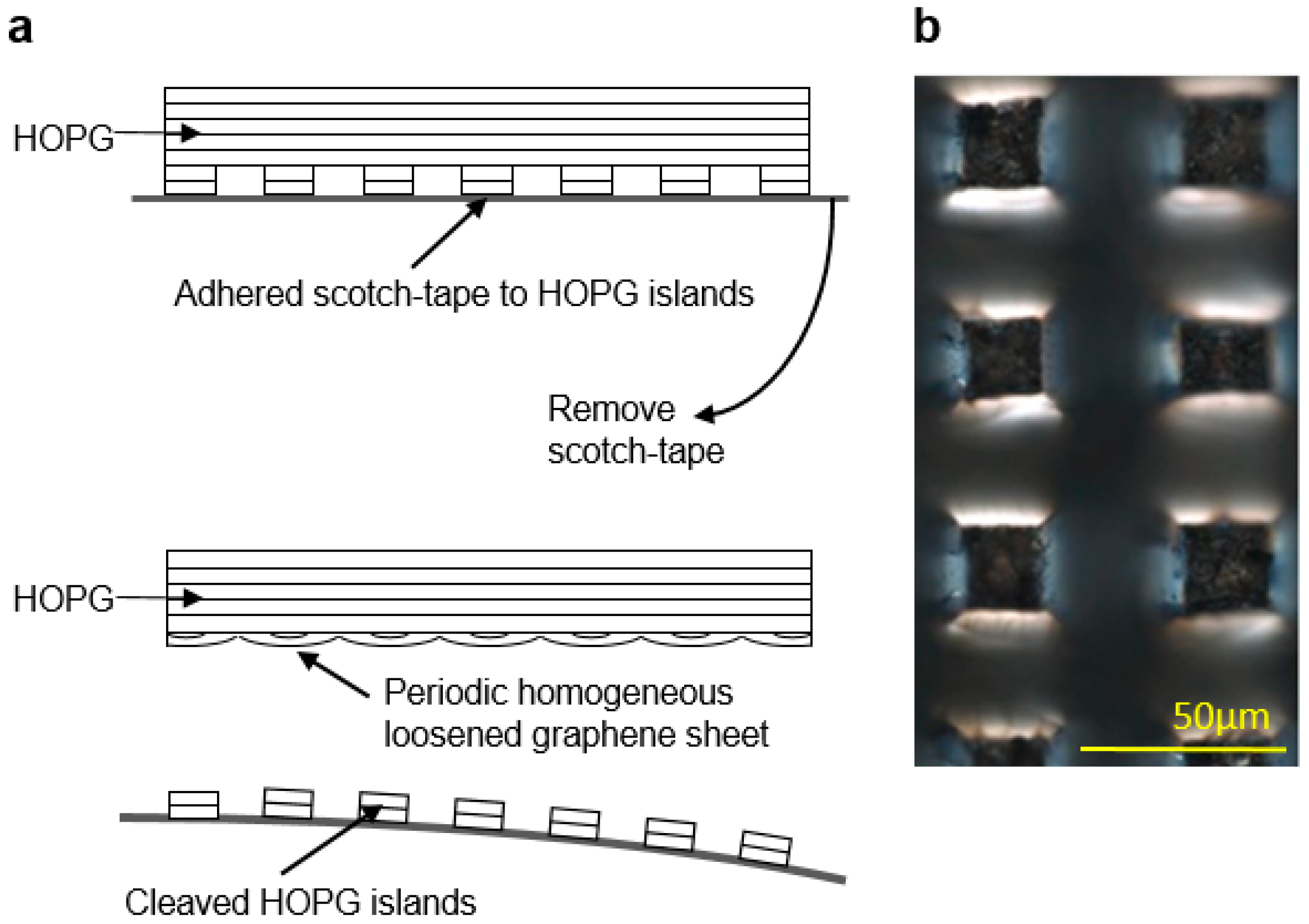
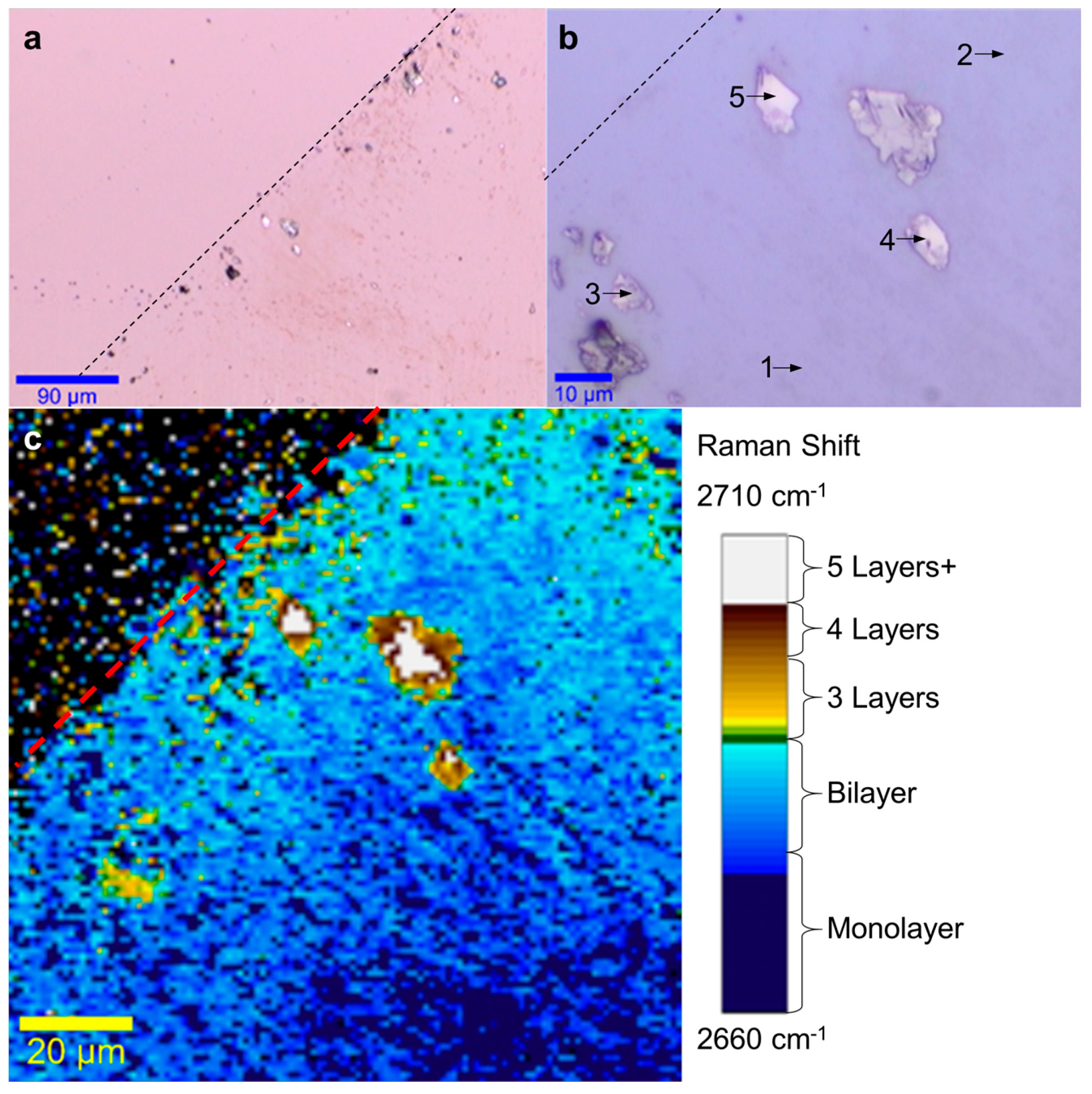
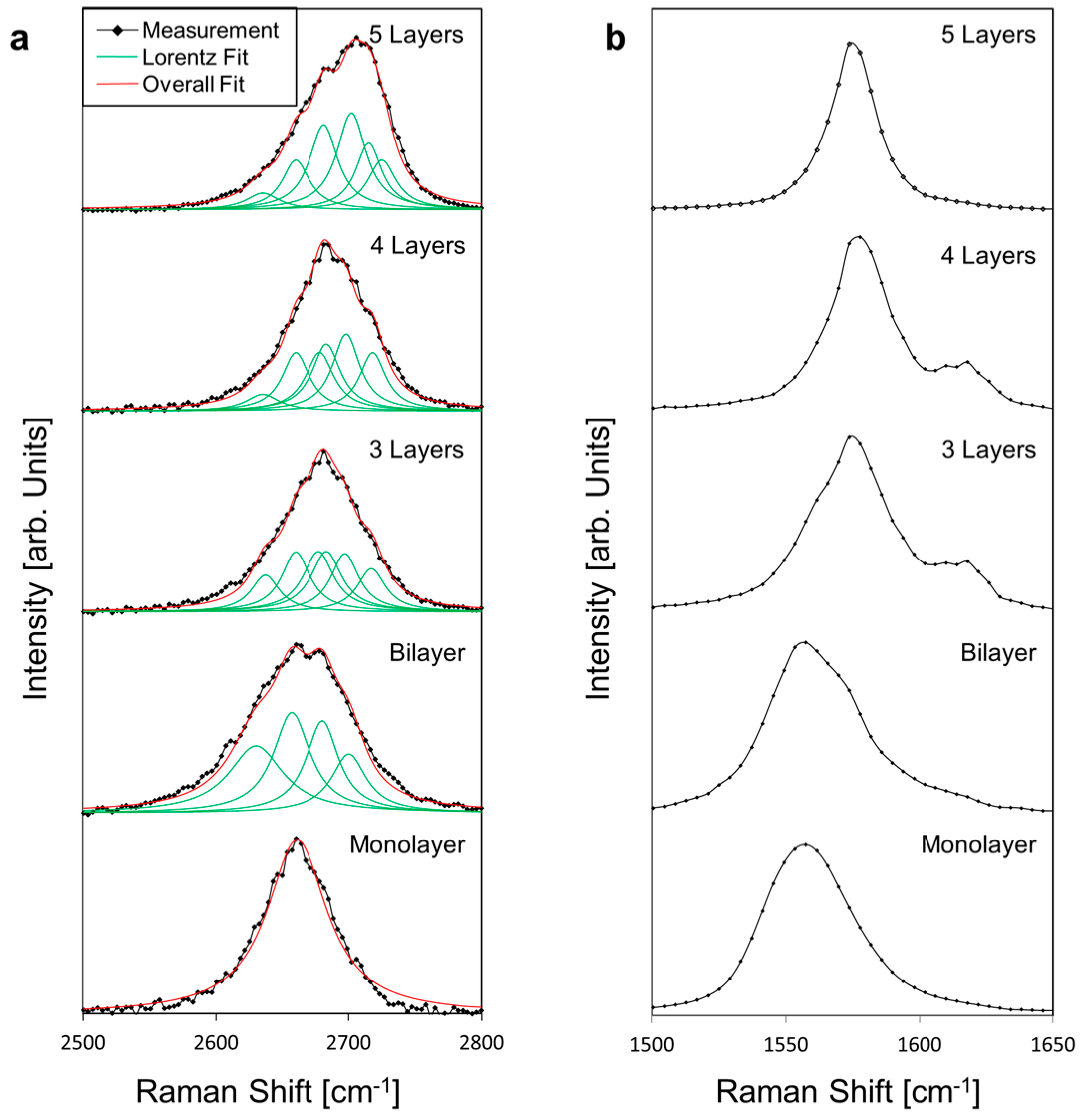

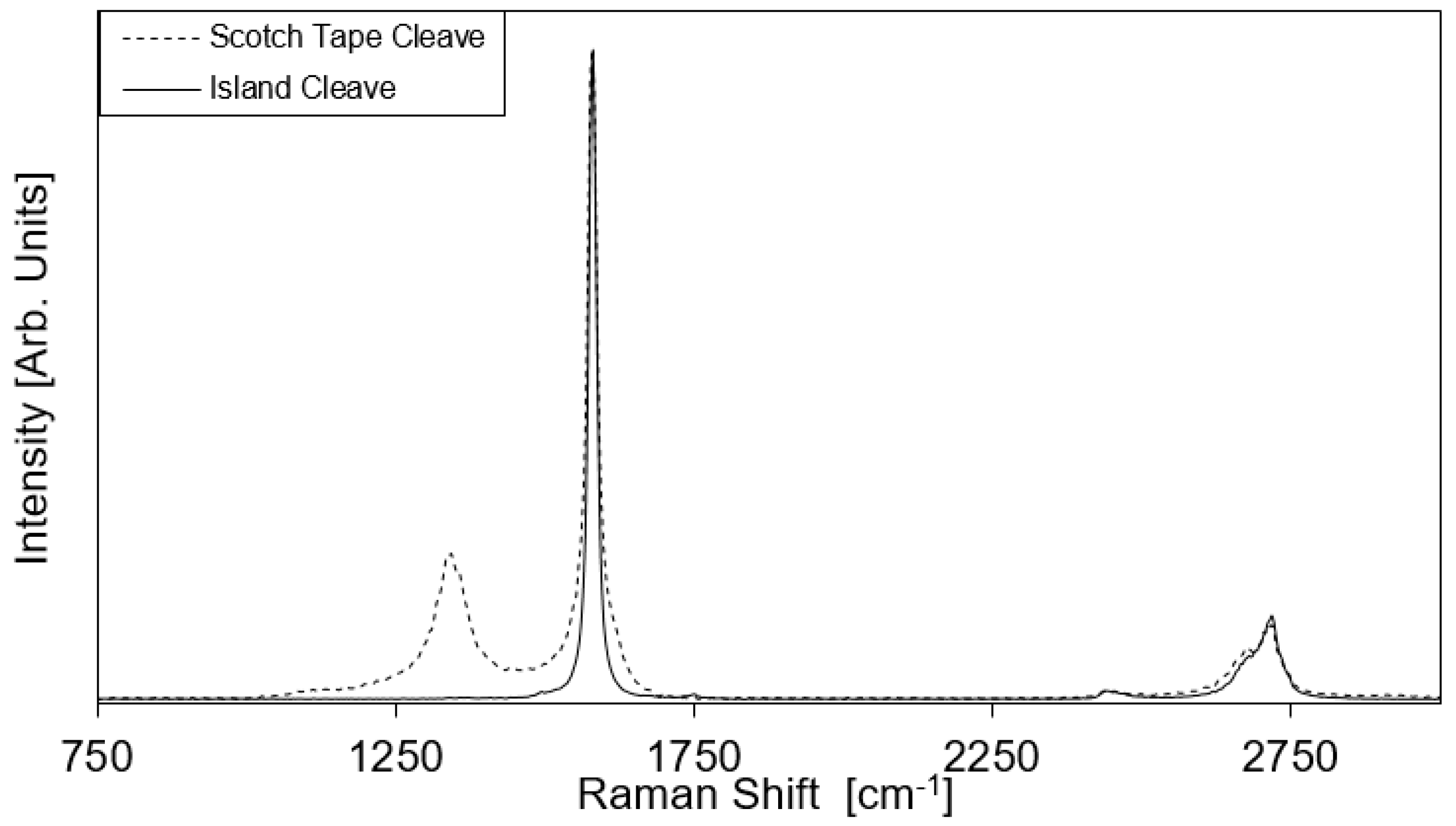

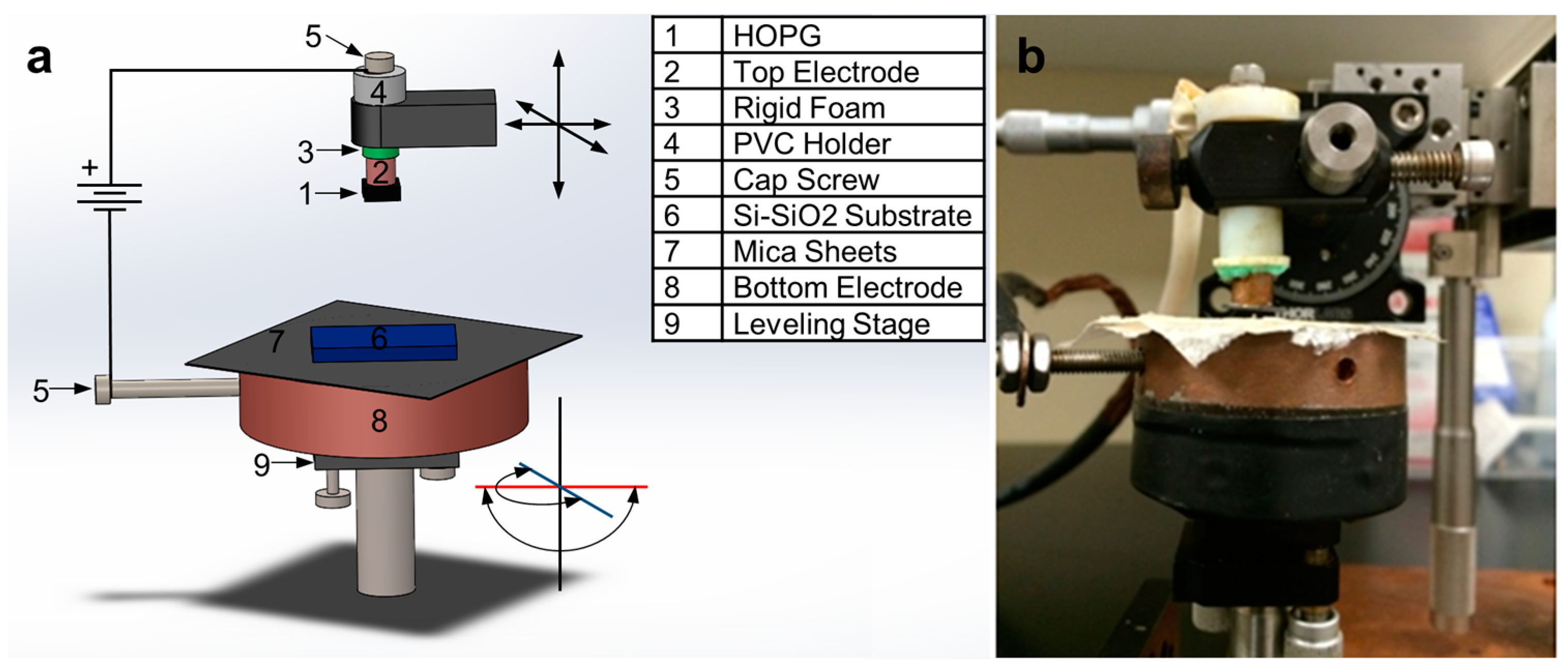

| Layers/Peaks | 2630 (cm−1) | 2660 (cm−1) | 2677 (cm−1) | 2683 (cm−1) | 2700 (cm−1) | 2717 (cm−1) | 2725 (cm−1) |
|---|---|---|---|---|---|---|---|
| Monolayer | - | 55 | - | - | - | - | - |
| Bilayer | 50 | 34 | 30 | - | 32 | - | - |
| 3 layers | 26 | 26 | 28 | 28 | 26 | 26 | - |
| 4 layers | 30 | 25 | 26 | 26 | 25 | 24 | - |
| 5 Layers | 30 | 25 | - | 26 | 27 | 24 | 26 |
© 2018 by the authors. Licensee MDPI, Basel, Switzerland. This article is an open access article distributed under the terms and conditions of the Creative Commons Attribution (CC BY) license (http://creativecommons.org/licenses/by/4.0/).
Share and Cite
Trudeau, C.; Dion-Bertrand, L.-I.; Mukherjee, S.; Martel, R.; Cloutier, S.G. Electrostatic Deposition of Large-Surface Graphene. Materials 2018, 11, 116. https://doi.org/10.3390/ma11010116
Trudeau C, Dion-Bertrand L-I, Mukherjee S, Martel R, Cloutier SG. Electrostatic Deposition of Large-Surface Graphene. Materials. 2018; 11(1):116. https://doi.org/10.3390/ma11010116
Chicago/Turabian StyleTrudeau, Charles, Laura-Isabelle Dion-Bertrand, Sankha Mukherjee, Richard Martel, and Sylvain G. Cloutier. 2018. "Electrostatic Deposition of Large-Surface Graphene" Materials 11, no. 1: 116. https://doi.org/10.3390/ma11010116
APA StyleTrudeau, C., Dion-Bertrand, L.-I., Mukherjee, S., Martel, R., & Cloutier, S. G. (2018). Electrostatic Deposition of Large-Surface Graphene. Materials, 11(1), 116. https://doi.org/10.3390/ma11010116






